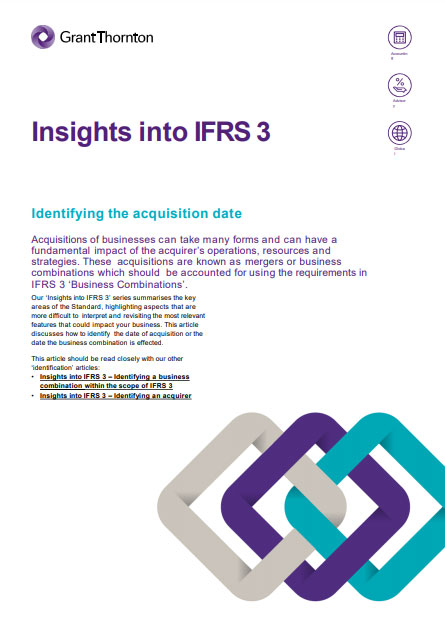-
Business Risk Service
Organisations must understand and manage risk and seek an appropriate balance between risk and opportunities.
-
Transaction Advisory, M& A, Business Consultancy
Transaction Advisory, M& A, Business Consultancy
-
IT Advisory
IT Advisory
-
Business Process Solutions
Business Process Solutions
-
Managing the VAT Audit
Managing the VAT Audit
-
Transfer Pricing
Global transfer pricing is all about understanding your business and the value drivers of your industry in an ever-changing environment.
Acquisitions of businesses can take many forms and can have a fundamental impact of the acquirer’s operations, resources and strategies. These acquisitions are known as mergers or business combinations which should be accounted for using the requirements in IFRS 3 ‘Business Combinations’.
This article discusses how to identify the date of acquisition or the date the business combination is affected.
We hope you find the information in this article helpful in giving you some insight into IFRS 3. If you would like to discuss any of the points raised, download our publication and speak to our Grant Thornton Bahrain contacts.
How does IFRS 3 define the acquisition date?
IFRS 3 defines the acquisition date as the date the acquirer obtains control of the acquiree. In a combination effected by a sale and purchase agreement, this is generally the specified closing or completion date (the date when the consideration is transferred and acquiree shares or underlying net assets are acquired).
The acquisition date is critical because it determines when the acquirer recognises and measures the consideration transferred, the assets acquired, and liabilities assumed. The acquiree’s results are consolidated from this date. The acquisition date materially impacts the overall acquisition accounting, including post-combination earnings.
The acquisition date is often readily apparent from the structure of the business combination and the terms of the sale and purchase agreement (if applicable) but this is not always the case. Complications can arise because of the many ways, both contractual and non-contractual, that business combinations can be put together.
The period between the start of negotiations and final settlement of all aspects of a combination can be protracted. Applicable corporate laws, shareholder approval requirements, competition rules and stock market regulations also vary and may affect the analysis and the date at which control is transferred to the acquirer.
Because no two business combination transactions are identical, there are few (if any) ‘rules of thumb’ to assist in identifying the acquisition date. Instead, the definition of control should be applied to the specific facts and circumstances of each situation. Judgement will often be required, and disclosure of the assessment made will need to be fully disclosed under the requirements of IAS 1 ‘Presentation of
Financial Statements’.
Example situations when determining the acquisition date
1. The purchase agreement specifies that control is transferred on an effective date different from the closing date
Consider whether the provisional effective date actually changes the acquisition date. In practice, many of these types of provisions are simply mechanisms to adjust the price but may not affect the date when control is obtained.
An agreement that artificially backdates the date of acquisition cannot justify the acquisition date (from an accounting perspective) being the earlier date. In other words, it cannot be subsequently decided that control took place at a date when the acquirer and the acquiree were unlikely having any relationship. Control cannot be decided afterwards on the basis of a contractual term that artificially places the acquisition date before the terms of the contract provided the acquirer with the benefits associated of returns from that date.
2. The purchase is complete subject to shareholder approval
Consider the date when the acquirer can effect change in the board of directors of the acquiree. Until the approval is obtained it would be difficult to consider that control has been transferred.
3. The purchase is complete subject to regulatory approval
Consider whether the date of regulatory approval is merely a formality.
For example, a target company operates in a market and jurisdiction where the acquirer is already a significant competitor. Where this transaction requires the approval of the competition authority in that jurisdiction, it would be difficult to conclude this regulatory approval is just a formality. Therefore, until the approval is obtained, control cannot have been transferred to the acquirer.
4. No closing date specified
Consider, for example, when an investee repurchases own shares held by other investors resulting in an existing shareholder becoming a majority shareholder. In this case, the starting point is to identify the date when the shareholder's proportionate voting rights amounted to a controlling interest.
5. Made by public offer
Consider the date a public offer becomes unconditional (with a controlling interest acquired).
6. The purchase is complete subject to other conditions
Consider the date when the acquirer starts directing the acquiree's operating and financing policies.
How we can help
We hope you find the information in this article helpful in giving you some insight into IFRS 3. If you would like to discuss any of the points raised, download our publication and speak to our Grant Thornton Bahrain contacts.
